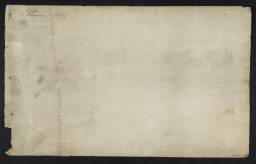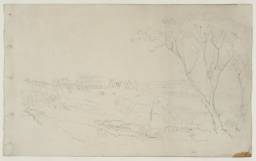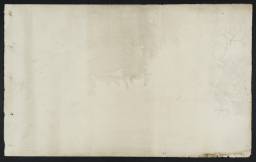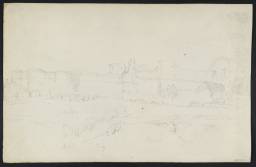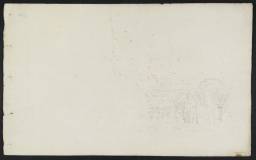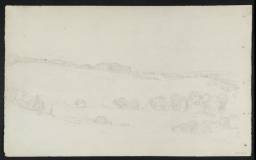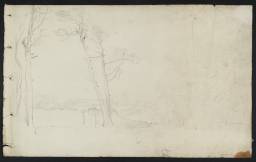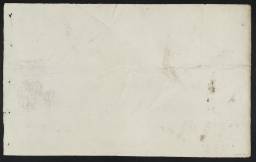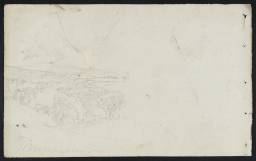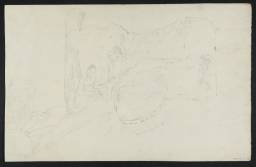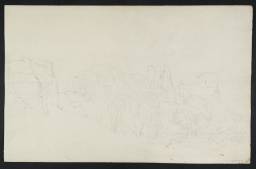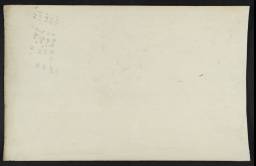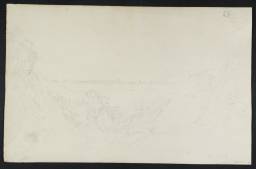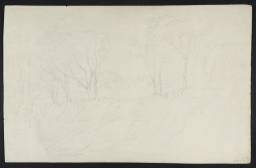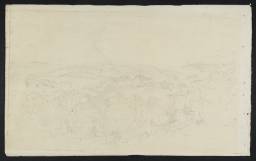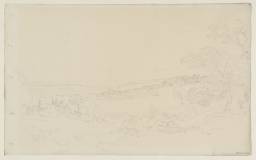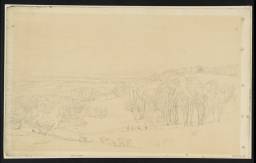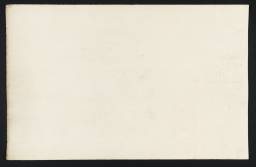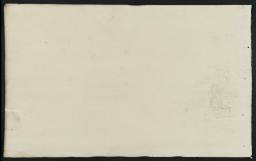Turner Bequest CXXXVIII
Assorted unbound sheets, probably originally from the same sketchbook
White wove paper, various sizes
Watermarked ‘J WHATMAN |1801’
Numbered 162 in the Turner Schedule, endorsed by the Executors of the Turner Bequest and signed in ink by Henry Scott Trimmer and Charles Turner ‘H.S. Trimmer’ and ‘C. Turner’ and in pencil by John Prescott Knight and Charles Eastlake ‘JPK’ and ‘C.L.E.’ on D10320
Turner Bequest CXXXVIII 1
White wove paper, various sizes
Watermarked ‘J WHATMAN |1801’
Numbered 162 in the Turner Schedule, endorsed by the Executors of the Turner Bequest and signed in ink by Henry Scott Trimmer and Charles Turner ‘H.S. Trimmer’ and ‘C. Turner’ and in pencil by John Prescott Knight and Charles Eastlake ‘JPK’ and ‘C.L.E.’ on D10320
Turner Bequest CXXXVIII 1
Accepted by the nation as part of the Turner Bequest 1856
Exhibition history
References
These leaves from a dismembered sketchbook have drawings of Sussex subjects datable to 1810 and later.
They were described by Finberg as ‘loose leaves with no covers. They were distributed [presumably by John Ruskin at an early stage] and there were no means of discovering their original sequence’. Finberg listed them, with page numbers, as the remnants of a sketchbook which he titled Views in Sussex. However, he believed that the original book also contained leaves with West Country subjects that he grouped as a separate Somerset and North Devon sketchbook (Tate D08945–D08946; D40294–D40295; D41531; Turner Bequest CXXVI 1–18). These drawings date from 1811. Finberg was surely right to associate both sets of drawings with a single sketchbook as they are on the same size and type of paper and have similar stitch holes in the margins. Moreover the combination of subjects and dates broadly follows that in the Vale of Heathfield sketchbook (Tate D10206–D10319, D40863–D40866, D41535; Turner Bequest CXXXVII D, though without additional Cumbrian subjects from 1809. Nevertheless, these two batches of drawings were given different Turner Bequest schedule numbers. In this catalogue the groups are also kept separate, with the Sussex material discussed here and the West Country drawings catalogued by Matthew Imms.
The Sussex drawings are connected with Turner’s work for John Fuller. High Sheriff of Sussex 1796–7 and MP for East Sussex 1801–12, landowner, ironmaster, slave owner and amateur scientist and astronomer, he was one of Turner’s most eccentric patrons.1 Their business association began in 1810, when Fuller asked Turner to make four watercolours of scenery at or near his estate at Rosehill (now Brightling) Park. Fuller was busy improving the house and park, with the architect Robert Smirke and the landscape designer Humphry Repton. His commission to Turner, initially for watercolours for hire, was reported by Joseph Farington:
Mr Fuller, member for Suffolk [sic; Sussex] has engaged Turner to go into that county to make drawings of three or four views. He is to have 100 guineas for the use of his drawings which are to be returned to him.
Turner made four watercolours: The Vale of Pevensey from Rosehill Park (Fitzwilliam Museum, Cambridge),2 Battle Abbey (private collection),3 The Vale of Ashburnham (University of Liverpool)4 and Beauport (Fogg Art Museum, Harvard University, Cambridge, Massachusetts).5 Specified by Fuller, the subjects included his own estate, two seats nearby and the historically charged landscape around Battle, site of the Battle of Hastings in 1066. About 1818, these were privately printed in coloured aquatints by Joseph Stadler for circulation among Fuller’s friends and distinguished neighbours. On 27 February 1810 Fuller, a volatile character, ‘got embroiled in an insane contest’ during a parliamentary enquiry into a disastrous expedition to Walcheren in the Netherlands the previous year,6 when many British troops died of fever. Having insulted the Speaker (as the ‘little insignificant fellow in the wig’) and become involved in a scuffle, Fuller was locked up for two days,7 much to the embarrassment of his constituency. His plan for presentation plates was probably part of a charm offensive, designed to rebuild bridges,8 although his genuine passion for the topography and history of his native county must also be acknowledged. As Farington indicated, Fuller at first rented Turner’s watercolours for reproduction, but then bought them.
Although Finberg dated this sketchbook 1815–16 it has long been recognised that it was in fact used in 1810 when Turner visited East Sussex to collect material for Fuller’s project. The leaves include the preliminary drawings for The Vale of Pevensey (D10342; Turner Bequest CXXXVIII 19), Battle Abbey (D10321–10322; Turner Bequest CXXXVIII 2–3), The Vale of Ashburnham (D10340; Turner Bequest CXXXVIII 17) and Beauport (D10341; Turner Bequest CXXXVIII 18) as well as the drawing (D10329; Turner Bequest CXXXVIII 10) used for the oil Rosehill Park, Sussex (private collection)9 which Turner painted for Fuller 1810–11. The painting and Turner’s first watercolour, looking towards and away from the house, formed complementary views.
Fuller bought another painting, Fishmarket on the Sands (William Rockhill Nelson Gallery and Atkins Museum of Fine Arts, Kansas City, Missouri)10 in 1810, from Turner’s Gallery; he paid for it on 26 July.11 The same year, Fuller made an anonymous visit to the studio of David Wilkie, surprising him by his ‘very rough manners’; see notes to the Harvest Home sketchbook (Tate D05351–D05375; D40273; D40342–D40343; Turner Bequest LXXXVI) for conjecture that he took over some interest in or is even portrayed in Turner’s unfinished, Wilkie-inspired painting Harvest Home (Tate N00562).12 In the next few years, probably about 1816, Turner made a further set of watercolours for Fuller. These too can be traced back to drawings made in 1810, with the certain exceptions of a close view of the house with later alterations by Robert Smirke (British Museum, London)13 and another of his Observatory at Brightling (currently untraced)14 based on drawings in the Hastings sketchbook (Tate D10390, D10392, D10394; Turner Bequest CXXXIX 32a, 33a, 34; D10394–D10395; Turner Bequest CXXXXIX 34a–35 respectively) which is watermarked 1815. As in the first set, the subjects comprise Fuller’s own property – Rosehill itself and his Observatory nearby; the neighbouring estates of Ashburnham Place, Crowhurst Park and Heathfield Park; and local antiquities and sites in which he took an interest, Herstmonceux and Pevensey Castles as well as Bodiam which he bought in 1829, and Winchelsea with the Royal Military Canal. Some of these were published by William Bernard Cooke between 1816 and 1820 as Views in Sussex.
Four of these later watercolours originate in drawings from this sketchbook. D10324; Turner Bequest CXXXVIII 5 served as the basis for Herstmonceux Castle (private collection),15 D10327; Turner Bequest CXXXVIII 8 for Pevensey Bay, from Crowhurst Park (private collection),16 D10331; Turner Bequest CXXXVIII 11 for Battle Abbey, the Spot where Harold Fell (currently untraced)17 and D10326; Turner Bequest CXXXVIII 7 for Pevensey Castle (private collection),18 which might date from the early 1820s and be the last work Turner made for Fuller.
Robert Upstone, ‘Fuller, Jack [John] (d.1834)’, in Evelyn Joll, Martin Butlin and Luke Herrmann eds., The Oxford Companion to J.M.W. Turner, Oxford 2001, p.117; Eric Shanes, Turner’s Rivers, Harbours and Coasts, London 1981, pp.5–6; J.P.J. Entract, ‘Fuller, John (1757–1834)’, Oxford Dictionary of National Biography, Oxford University Press, 2004; online edn, May 2008 [http://www.oxforddnb.com/view/article/39364, accessed 13 September 2011.
K. Dian Kriz, The Idea of the English Landscape Painter: Genius as an Alibi in the Early Nineteenth Century, New Haven and London 1997, pp.98–9; Kim Sloan. J.M.W. Turner: Watercolours from the R.W. Lloyd Bequest, London 1998, p.58.
Technical notes
How to cite
David Blayney Brown, ‘Views in Sussex sketchbook c.1810–17’, sketchbook, April 2011, in David Blayney Brown (ed.), J.M.W. Turner: Sketchbooks, Drawings and Watercolours, Tate Research Publication, December 2012, https://www

